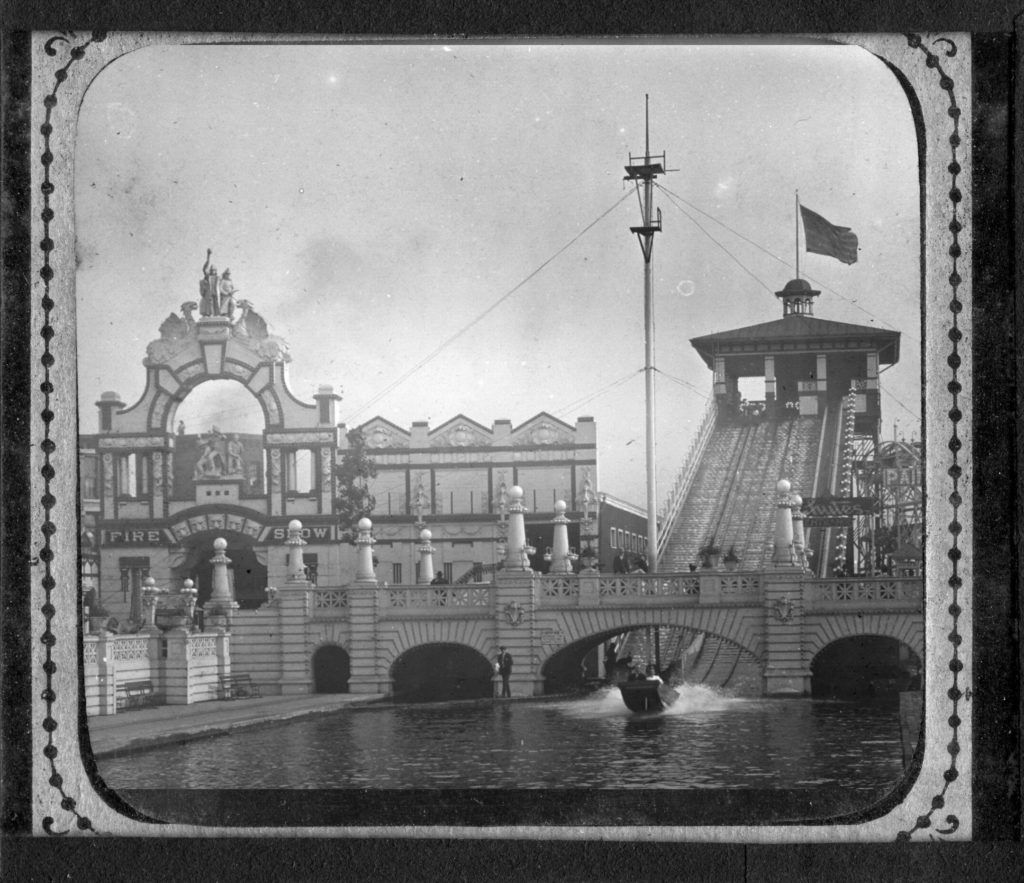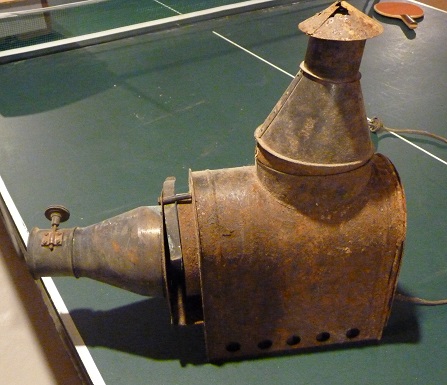
Before there were talkies, there were movies. Before there were movies there were magic lanterns. In the late 1800s and early 1900s much of society was enthralled with the new technology of photography and the improvements it had seen since the American Civil War. In the home, stereoscopes enabled individuals to see photographs in three dimensions. And the magic lanterns that had projected images drawn on glass slides by hand since the early 1800s could enable groups of people to view large projected photographic images. Some of the projectors had two sets of lenses (These were called stereopticons.) that enable the presenter to do fading blends from one slide to the next. Some projectors made it possible to present “moving pictures” by sliding an image through the projector during display.
The earliest magic lanterns used either a candle or a kerosene lamp type burner as a light source. These were suitable for only small groups. When the electric light bulb was developed, its brightness enabled presenting slide shows to large groups.
Magic lanterns were used at times in homes. There were even children’s versions. As the light source improved so that image would be bright enough for larger groups to view them together, magic lanterns were used in theaters and the early nickelodeons, not always as the main attraction, but as lead-ins to live stage productions, or as a way to keep people’s attention during the reel changes of the early silent movies. Sometimes they presented images of things in the news – a precursor to the newsreel. At times they portrayed interesting places. Very often they were used to lead the audience or to accompany a stage performer in song. Such “illustrated song” shows were often used to promote new songs and encourage people to buy the sheet music.
Sometime in my paternal grandfather’s history he came to have a magic lantern and a collection of the glass slides. I can only guess at how he came by them. Perhaps, he got them from someone he dealt with when he was a printer. Since my father was an only child, the collection came to us. But we did not have a good place to keep such memorabilia. We really didn’t have adequate room for the family (There were nine of us.). So Grandpa’s magic lantern and slides went to the basement where it was almost always dark (good for the slides) but also always humid (not good for either the lantern or the slides). By the time the collection came into my possession, the magic lantern was beyond repair and many of the slides were damaged from both humidity and breakage.

Still, in spite this and the deterioration that time imposes on every photographic image, the collection still exists and many of the slides still have fairly good images. So that I can share these images with my siblings and with others who might be interested, I’ve taken on the project of digitizing them. From time to time I will be posting “thumbnail” images on this website. Because they’re all in the public domain (The newest is from 1910.) others are welcome to copy and use them. The posted images are at 90 dpi. (The original glass slides measure 4” wide by 3” tall.) If any would like a copy of the original scanned file (600 dpi and 16 bit greyscale or color), I can arrange that in exchange for a contribution to this work.
Magic lantern slides are not really rare, and these images are not pristine. I did not clean the dust off or repair the broken glass. I have tweaked the brightness and contrast a bit to counter some of the fading. The slides have been scanned twice – once to get the film image and once to get the framing and any identifying text on the edges of the slides. These have been combined as well as I can with the equipment I have.
The slides are made primarily of two pieces of very thin glass. One of them has the photographic image chemically etched onto an inner surface. The second piece of glass protects the photographic image from being scratched off the surface of the first piece of glass. Between the the two pieces of glass there is often a paper frame and, in some cases, a label identifying the image. The two pieces of glass are held together with a strip of adhesive tape around the perimeter.
I think this collection came originally from the photographer who took the images, for included with the slides are a few boxes of blank slides and other materials for making the finished slides. Unfortunately, none of the blanks are usable, for they have all been exposed to light. (“What’s in here?) If the photographer made these slides, he was a very well traveled man, for the collection includes images from Boston, Galveston, Chicago Montana, Florida, Ohio, Oregon, Havana Cuba, and the Philippines. Some of them were taken in 1910, others in 1907, others in 1905, and I suspect they were all taken between the Spanish American War and 1911.
The first group of slides I’m posting is made up of seven photos of United States Navy ships. (Click the “Great White Fleet” button, below.) Some of the labels indicate they were taken in Boston (the Boston Navy Shipyard at Cambridge, MA), which leads to the conclusion that they were taken in 1905 when these ships were there for maintenance.
The second group is a small collection featuring the first airplane flight from Chicago to St. Louis.
As additional groups of slides are ready for posting, I plan to add addition button links to them.